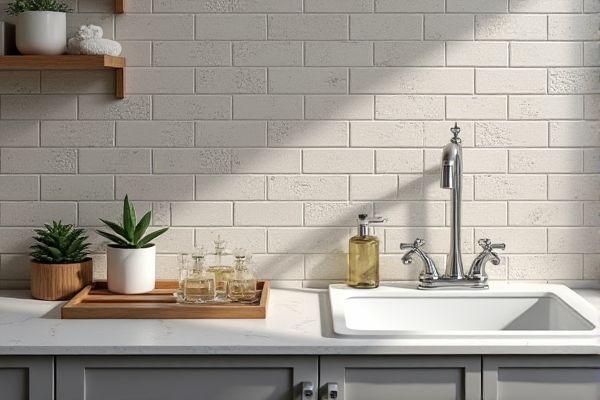
Mosaic tiles offer intricate patterns and a textured appearance ideal for adding visual interest to your space, while subway tiles provide a classic, clean look that suits various design styles with their rectangular shape and smooth finish. Discover which tile style best complements your interior design needs by reading the full article.
Table of Comparison
| Feature | Mosaic Tile | Subway Tile |
|---|---|---|
| Size | Small pieces, typically 1x1 inch or smaller | Rectangular, typically 3x6 inches |
| Design | Intricate patterns, varied colors and textures | Simple, uniform look with clean lines |
| Installation | More complex and time-consuming | Faster and easier to install |
| Cost | Higher due to labor and material complexity | Generally lower and more budget-friendly |
| Maintenance | Requires frequent grout cleaning due to many joints | Easier to clean with fewer grout lines |
| Common Uses | Accent walls, backsplashes, decorative features | Bathrooms, kitchens, showers, backsplash |
| Style | Artistic, decorative, varied aesthetics | Classic, timeless, minimalist |
Introduction to Mosaic Tile and Subway Tile
Mosaic tile consists of small, often square-shaped pieces made from materials like glass, ceramic, or stone, arranged to create intricate patterns or images, offering versatility in design and texture. Subway tile is a rectangular, typically 3x6 inch ceramic tile known for its clean, uniform look inspired by early 20th-century New York City subway stations, favored for its classic and timeless appeal. Both tile types serve distinct aesthetic and functional purposes, with mosaic tiles excelling in decorative applications and subway tiles being ideal for sleek, minimalist surfaces.
Key Differences Between Mosaic and Subway Tile
Mosaic tile consists of small, often varied shapes and colors arranged in intricate patterns, providing a highly decorative and customizable surface ideal for backsplashes or accent walls. Subway tile features larger, uniform rectangular pieces typically in a glossy white finish, offering a classic, clean look that enhances brightness and simplicity in kitchens or bathrooms. Your choice between mosaic and subway tile depends on the desired visual impact, with mosaics delivering texture and complexity while subway tiles emphasize timeless elegance and ease of maintenance.
Design Aesthetics: Mosaic vs Subway Tile
Mosaic tiles offer intricate patterns and vibrant color mixes that create detailed, eye-catching designs, ideal for adding artistic flair and texture to walls or backsplashes. Subway tiles present a clean, classic, and uniform look with their rectangular shape and simple grout lines, providing a timeless aesthetic that complements modern and traditional interiors alike. Choosing between mosaic and subway tiles depends on whether a space demands bold visual complexity or streamlined minimalism.
Popular Applications in Interior Spaces
Mosaic tiles are widely used in bathrooms and kitchen backsplashes for intricate, decorative patterns that add texture and visual interest to smaller areas. Subway tiles dominate in contemporary kitchens and restroom walls, valued for their clean, classic look and ease of installation, making large surfaces appear bright and spacious. Both tile types enhance interior design by providing durable, moisture-resistant surfaces suitable for high-traffic zones such as showers, countertops, and accent walls.
Material and Size Comparison
Mosaic tiles feature small, often square or hexagonal shapes made from materials like glass, ceramic, or natural stone, typically measuring 1x1 inch or smaller, allowing for intricate patterns and detailed designs. Subway tiles are larger, usually rectangular ceramic or porcelain pieces around 3x6 inches, prized for their classic, clean look and ease of installation. Choosing between mosaic and subway tiles depends on your design goals and space, with mosaics offering texture and visual complexity while subway tiles provide timeless simplicity.
Installation Process and Complexity
Mosaic tile installation involves placing numerous small tiles in intricate patterns, requiring precise alignment and detailed grouting, which increases labor time and skill levels. Subway tiles consist of larger, uniform rectangles that allow for faster installation with fewer grout lines, simplifying both cutting and placement. Professional expertise may be necessary for mosaic tiles due to their complexity, while subway tiles are often suitable for DIY projects because of their straightforward installation process.
Durability and Maintenance Needs
Mosaic tiles, made from materials like glass, ceramic, or natural stone, typically offer high durability but may require more frequent cleaning due to their numerous grout lines. Subway tiles, usually ceramic or porcelain, provide a durable and low-maintenance option, with larger tile sizes reducing grout exposure and easing upkeep. Your choice depends on the balance between aesthetic preference and the time you're willing to dedicate to ongoing maintenance.
Cost Comparison: Mosaic Tile vs Subway Tile
Mosaic tile generally costs more per square foot compared to subway tile due to its intricate patterns and smaller size requiring more labor for installation. Subway tile, often made from ceramic or porcelain, offers a budget-friendly option with lower material and installation expenses, making it suitable for large surface areas. Homeowners looking to balance aesthetics and cost typically find subway tiles provide a more economical solution while mosaic tiles add premium decorative value.
Pros and Cons of Each Tile Type
Mosaic tiles offer intricate patterns and design flexibility, making them ideal for accent walls and small spaces, but they require more grout maintenance and can be challenging to install. Subway tiles provide a classic, clean look with easier installation and durability, yet they may lack the visual complexity and customization found in mosaics. Choosing between mosaic and subway tiles depends on the desired aesthetic, maintenance willingness, and installation skill level.
Choosing the Right Tile for Your Space
Mosaic tiles offer intricate patterns and vibrant color options, ideal for creating focal points or accent walls, especially in bathrooms and kitchens where visual interest is desired. Subway tiles provide a classic, clean, and timeless look with their rectangular shape and uniform size, making them perfect for larger wall areas or backsplashes in traditional and modern designs. Selecting between mosaic and subway tiles depends on the desired aesthetic, space size, and maintenance preferences, with mosaic tiles requiring more grout cleaning and subway tiles offering easier upkeep.
 homyna.com
homyna.com